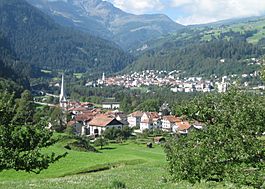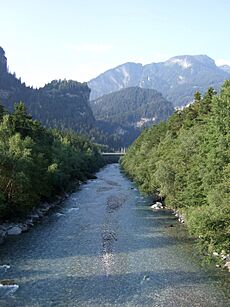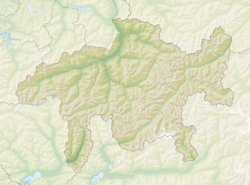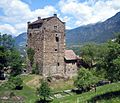Sils im Domleschg facts for kids
Quick facts for kids
Sils im Domleschg
|
||
|---|---|---|

Sils im Domleschg (foreground)
|
||
|
||
| Country | Switzerland | |
| Canton | Graubünden | |
| District | Viamala | |
| Area | ||
| • Total | 9.28 km2 (3.58 sq mi) | |
| Elevation | 633 m (2,077 ft) | |
| Population
(Dec 2020 )
|
||
| • Total | 971 | |
| • Density | 104.63/km2 (271.00/sq mi) | |
| Postal code |
7411
|
|
| Surrounded by | Fürstenau, Mutten, Rongellen, Scharans, Thusis, Vaz/Obervaz, Zillis-Reischen | |
Sils im Domleschg (called Seglias in Romansh) is a small town, also known as a municipality, in the Viamala Region of the Swiss canton of Graubünden. It's a lovely place located between two rivers, the Albula and the Hinterrhein.
Contents
A Look Back in Time
Sils im Domleschg was first mentioned in old records way back in 1149. Back then, it was known as de Sillas. Imagine how much has changed since then!
Exploring the Land

Sils im Domleschg covers an area of about 9.28 square kilometers (or 3.58 square miles).
- About 14.6% of this land is used for farming.
- A large part, 70.4%, is covered by forests.
- About 8.2% has buildings and roads.
- The remaining 6.9% is land that can't be used for farming or building, like rocky areas.
Over the years, the amount of land with buildings has grown a bit. Also, the forests have gotten bigger, while farming land has slightly decreased. Rivers and lakes make up about 11 hectares (or 27 acres) of the municipality.
Sils im Domleschg is a "linear village." This means it stretches out in a line, following the path between the Albula and Hinterrhein rivers. It includes the main village of Sils im Domleschg and smaller areas called hamlets like Freihof, Campi, and Albula.
Who Lives Here?
As of 2015, Sils im Domleschg has a population of 927 people.
- About 16.3% of the people living here are from other countries.
- In 2015, a small group (about 5.4%) of the people were born in Portugal.
- Between 2010 and 2014, the population grew by about 5.6%.
- In 2014, for every 1,000 people, 11 babies were born, and 5.5 people passed away.
Looking at age groups in 2014:
- Children and teenagers (0–19 years old) make up 21.5% of the population.
- Adults (20–64 years old) are 58.1%.
- Seniors (over 64 years old) are 20.3%.
Most people in Sils im Domleschg live in private homes. In 2000, about half of the inhabited buildings were single-family homes.
Here's how the population has changed over time:
| year | population |
|---|---|
| 1803 | 277 |
| 1850 | 295 |
| 1900 | 621 |
| 1910 | 541 |
| 1950 | 590 |
| 1960 | 737 |
| 1970 | 762 |
| 1980 | 826 |
| 1990 | 794 |
| 2000 | 880 |
What Languages Are Spoken?
Most people in Sils im Domleschg speak German. In 2000, about 86.8% of the population spoke German. The next most common languages were Serbo-Croatian (3.3%) and Italian (2.8%).
Here's a look at the main languages spoken over the years:
| Languages | Census 1980 | Census 1990 | Census 2000 | |||
|---|---|---|---|---|---|---|
| Number | Percent | Number | Percent | Number | Percent | |
| German | 612 | 74.09% | 646 | 81.36% | 764 | 86.82% |
| Romansh | 56 | 6.78% | 34 | 4.28% | 14 | 1.59% |
| Italian | 104 | 12.59% | 60 | 7.56% | 25 | 2.84% |
| Population | 826 | 100% | 794 | 100% | 880 | 100% |
Important Historical Sites
Sils im Domleschg is home to several important historical sites that are recognized as heritage sites of national significance in Switzerland. These include:
- Ehrenfels Castle
- Carschenna, which has very old petroglyphs (rock carvings from prehistoric times)
- The ruins of Hohenrätien Castle
- The ruins of Campell or Campi Castle
These sites tell us a lot about the history of the area!
Learning and Education
Many adults in Sils im Domleschg have a good education. About 73.3% of people aged 25-64 have completed either high school or gone on to higher education, like university.
How People Make a Living
Sils im Domleschg is a place where most jobs are in industry or services, rather than farming.
- In 2014, 287 people had jobs in the municipality.
- A small number (14 people) worked in farming (the primary economic sector).
- More people (160 workers) were in the secondary sector, which includes manufacturing and construction.
- The largest number of jobs (113) were in the tertiary sector, which means service jobs like shops, offices, and tourism.
Religious Beliefs
According to the 2000 census:
- About 33% of the people were Roman Catholic.
- About 55.4% belonged to the Swiss Reformed Church.
- Smaller groups belonged to the Orthodox Church or other Christian churches.
- About 0.99% of the population was Muslim.
- About 4.57% of people said they had no religion, or were agnostic or atheist.
See also
 In Spanish: Sils im Domleschg para niños
In Spanish: Sils im Domleschg para niños










